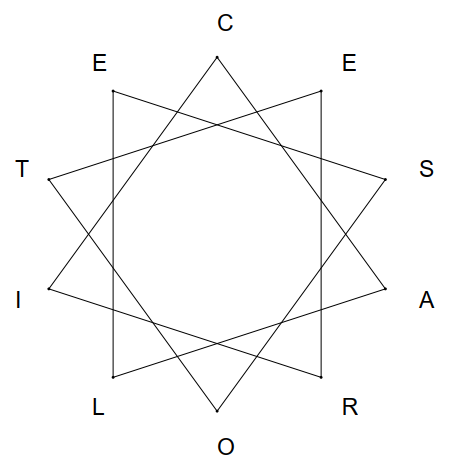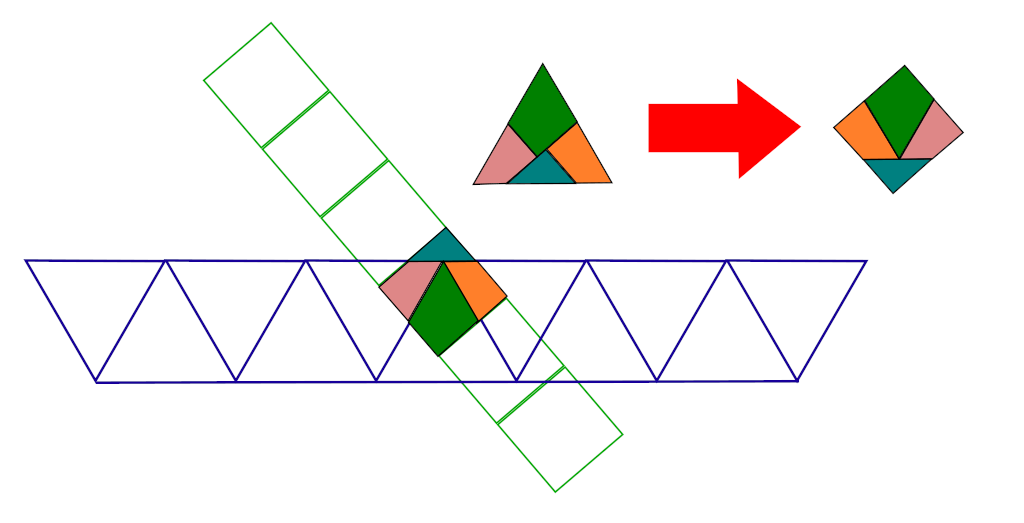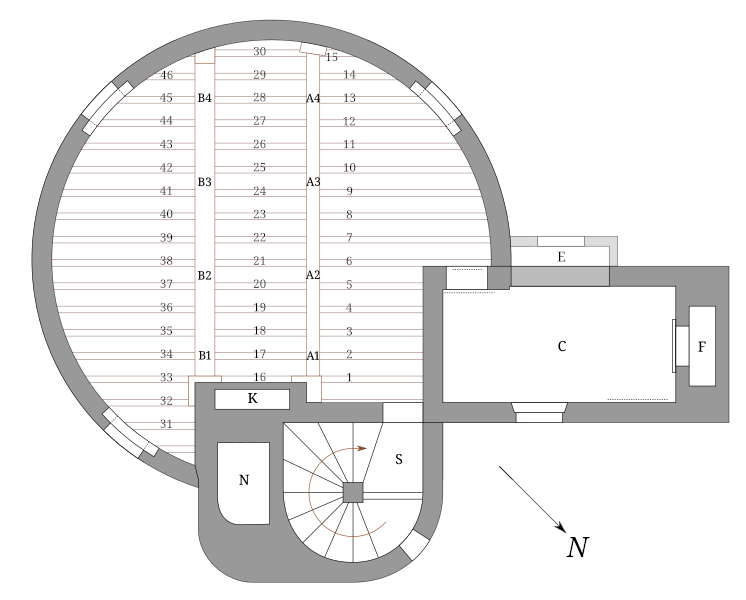-ESS changes POET to POETESS, -ETTE changes BACHELOR to BACHELORETTE, -INA changes CZAR to CZARINA, and -INE changes HERO to HEROINE. What suffix changes a word from feminine to masculine?
Search Results for: in a word
A Pretty Find
Write the word CESAROLITE in a circle and then trace out the letters in its anagram ESOTERICAL — the result is a perfect 10-pointed star:

Only 5.7 percent of anagrams in English are “maximally shuffled,” meaning that no letter retains its original neighbors. And even those rarely produce such pleasing symmetry when they’re diagramed like this. This is the largest “perfect” star anagram found in a systematic search by Jason Parker and Dan Barker; for more, see the link below.
(Jason Parker and Dan Barker, “Star Anagram Detection and Classification,” Recreational Mathematics Magazine 12:20 [June 2025], 19-40.)
“Hence These Rimes”
Tho’ my verse is exact,
Tho’ it flawlessly flows,
As a matter of fact
I would rather write prose.
While my harp is in tune,
And I sing like the birds,
I would really as soon
Write in straightaway words.
Tho’ my songs are as sweet
As Apollo e’er piped,
And my lines are as neat
As have ever been typed,
I would rather write prose —
I prefer it to rime;
It’s less hard to compose,
And it takes me less time.
“Well, if that be the case,”
You are moved to inquire,
“Why appropriate space
For extolling your lyre?”
I can only reply
That this form I elect
‘Cause it pleases the eye,
And I like the effect.
— Bert Leston Taylor
Hypertension
New English verb tenses, offered by David Morice in a November 1986 Word Ways article:
Future past perfect: I will have had walked
Progressive conditional: I would have should have been walking
Future present past: He will does walked
Double future: He will will walk
Unconditional present: He could can walk
Obsessive progressive: He is being doing walking
Refractive future perfect: He did will was have walked
Superjunctive: He might be having been about to be walking
The Tortoise stepped ever so carefully across the finish line, just a moment before the Hare would have been about to be going to hop across it himself. ‘I won!’ she said. The Hare paused a moment, then replied, ‘Yes, Ms. Tortoise, in the next decade you will have been about to be going to be used to be having been doing being the winner of this race, but tomorrow we’ll have to do it again, for it’s two out of three, ma’am.’
Footwork

Thomas Jefferson coined the word pedicure (at least in the sense “a person responsible for pedicure”).
His memorandum book for February 7, 1785, reads “P[ai]d La Forest, pedicure 12f.”
(Thanks, Joseph.)
Poem
The sum of 2k – 4
From one to thirteen plus a score,
Over eleven,
Plus eighteen times seven,
Equals six cubed and not a bit more.
(Will Nediger, “Can Math Limericks Survive?”, Word Ways 37:3 [August 2004], 238.)
The Perfect Infinitive
“Let us take a typical case. A gentleman and his wife, calling on friends, find them not at home. The gentleman decides to leave a note of regret couched in a few well-chosen words, and the first thing he knows he is involved in this:
We would have liked to have found you in.
“Reading it over, the gentleman is assailed by the suspicion that he has too many ‘haves,’ and that the whole business has somehow been put too far into the past. … He takes an envelope out of his pocket and grimly makes a list of all the possible combinations, thus getting:”
- We would have liked to have found
- We would have liked to find
- We would like to have found
- We would like to find
- We had hoped to have been able to have found
“If he has married the right kind of woman, she will hastily scratch a brief word on a calling card, shove it under the door, and drag her husband away.”
— James Thurber, “Ladies’ and Gentlemen’s Guide to Modern English Usage,” 1931
Piecework
In his Canterbury Puzzles of 1907, Henry Dudeney posed a now-famous challenge: How can you cut an equilateral triangle into four pieces that can be reassembled to form a perfect square?
Dudeney’s beautiful solution was accompanied by a rather involved geometric derivation. It seems unlikely that he worked this out laboriously in approaching an answer to the problem, but how then did he reach it?
Here’s one possibility: If a strip of squares is draped adroitly over a strip of triangles, their intersection forms a wordless proof of the task’s feasibility:

Whether that was Dudeney’s path to the solution is not known, but it appears at least plausible.
Elevated Thoughts

The joists in the tower in which Montaigne wrote his Essays are inscribed with his favorite quotations from Greek and Latin authors, many of which appear in his writings: “It is not so much things that torment man, as the opinions he has of things.” “Every reasoning has its contrary.” “Wind swells bladders, opinion swells men.”
He wrote, “The room pleases me because it is somewhat difficult of access, and retired, as much on account of the utility of the exercise, as because I there avoid the crowd. Here is my seat, my place, my rest. I try to make it purely my own, and to free this single corner from conjugal, filial, and civil community.”
The numbers in the diagram below correspond to this table in the German Wikipedia. English translations are here.
In large Latin letters on the central rafter are the words “I DO NOT UNDERSTAND. I PAUSE. I EXAMINE.”

Unquote

“The discovery of a new dish does more for human happiness than the discovery of a new star.” — Jean Anthelme Brillat-Savarin

